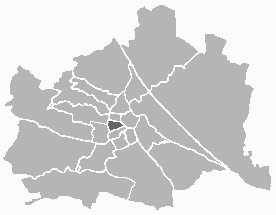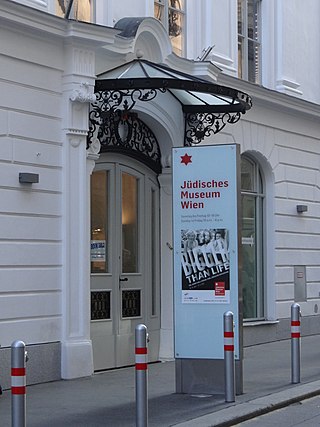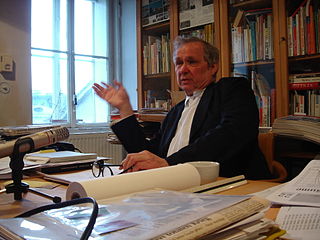
Neubau is the seventh district of Vienna. It is located near the center of Vienna and was established as a district in 1850, but borders changed later. Neubau is a heavily populated urban area, with a major shopping area and residential buildings. It has a population of 32,027 people within an area of 1.61 km² (0.62 sq.mi.).

The Museumsquartier (MQ) is a 90,000 m2 large area in the 7th district of the city of Vienna, Austria.

Oskar Strnad was an Austrian architect, sculptor, designer and set designer for films and theatres. Together with Josef Frank he was instrumental in creating the distinctive character of the Wiener Schule der Architektur. He stood for a modern concept of "living" for all people, planned and built private dwelling-houses, designed furniture, created ceramics and watercolours and designed sets and props for stage plays and films.

Friedrich Achleitner was an Austrian poet and architecture critic. As a member of the Wiener Gruppe, he wrote concrete poems and experimental literature. His magnum opus is a multi-volume documentation of 20th-century Austrian architecture. Written over several decades, Achleitner made a personal visit to each building described. He was a professor of the history and theory of architecture at the University of Applied Arts Vienna.

Karl Heinz is an Austrian architect. With two colleagues, as the firm Heinz & Mathoi & Streli, he built private homes in the alpine landscape of Tyrol, schools, offices and public buildings, among others.

The Künstlerhaus in Vienna's 1st district has accommodated the Künstlerhaus Vereinigung since 1868. It is located in the Ringstrassenzone in between Akademiestraße, Bösendorferstraße and Musikvereinsplatz.

The Jüdisches Museum Wien, trading as Jüdisches Museum der Stadt Wien GmbH or the Jewish Museum Vienna, is a museum of Jewish history, life and religion in Austria. The museum is present on two locations, in the Palais Eskeles in the Dorotheergasse and in the Judenplatz, and has distinguished itself by a very active programme of exhibitions and outreach events highlighting the past and present of Jewish culture in Austria. The current director is Barbara Staudinger and the chief curator is Astrid Peterle.
Marianne Maderna is an Austrian installation artist.

The Haus der Musik in Vienna opened in 2000, and is the first museum of sound and music in Austria. Across an exhibition space of 54,000 sq. ft., a range of hi-tech interactive and multimedia presentations introduce the world of music, from the earliest human use of instruments to the music of the present day.

Belvedere 21, formerly 21er Haus or Einundzwanziger Haus, is a modernist style steel and glass building designed by Austrian architect Karl Schwanzer (1918–1975). Originally constructed as the Austrian pavilion or temporary showroom for the Expo 58 in Brussels, it was later transferred to Vienna to house the Museum of the 20th Century, which explains why it was first nicknamed "20er Haus". Between 1979 and 2001, the building also acted as a depository for contemporary art works. From 2009 to 2011, it was remodeled by the architect Adolf Krischanitz and consequently renamed 21er Haus to reflect the 21st century. It was renamed Belvedere 21 in 2018.
Margherita Spiluttini was an Austrian photographer specializing in architecture. Spiluttini’s photo archive is one of the most important collections of photographs of architecture in Austria from 1980 to 2005.
Volker Giencke in Wolfsberg is an Austrian architect.

Laura Patricia Spinadel is an Austrian Argentine architect, urban planner, writer, educator and principal of the firm BUSarchitektur and of the company BOA büro für offensive aleatorik in Vienna. Laura P. Spinadel has made an international name based on her Compact City and Campus WU works, both considered pioneers of the holistic architecture ideology. She is Doctor Honoris Causa at the Civic Parliament of the Humanity, Transacademy Universal Institute of Nations.

Hermann Czech is an Austrian architect. He was born and lives in Vienna, Austria, where he has a private practice.

World-Information Institute (WII) is an independent cultural institution located in Vienna, Austria linking research and public discourse in the realms of innovation, digital culture technologies, and society. Its vast documentation and processing of digital media technologies sheds light on the future perspectives of global developments and involves complex and heterogeneous information resources.
The Palais des Beaux Arts is a residential and office building at Löwengasse 47-47A in Vienna's third district, Landstraße. The building has housed the embassies of the Republic of Lithuania and the Republic of Moldova since 1994. The building was erected between 1908 and 1909 by Anton and Josef Drexler, who also designed several houses on Rudolf-von-Alt-Platz and contributed other designs to the surrounding Weißgerberviertel quarter of the district. The building was originally built as home to Chic Parisien, a center for fashion.

Wien Nordwestbahnhof is a goods station in transformation to a city development area in Brigittenau district of Vienna, Austria. Passenger transport ended in 1959. It serves as the southern terminus of the Austrian Northwestern Railway. The northwestern terminus of the line was Prague Těšnov station till 1972. Freight transport is in the phase of termination. By 2025, a new district will be built on the site. An interim use phase will begin in 2018.
Elke Krasny is a cultural and architectural theorist, urban researcher, curator, and author. Her work specializes in architecture, contemporary art, urbanism, feminist museology, histories and theories of curating, critical historiographies of feminism, politics of remembrance, and their intersections. Krasny received her Ph.D. from the University of Reading. She is Professor of Art and Education at the Academy of Fine Arts Vienna. She worked as a visiting professor at the University of Bremen and the Academy of Fine Arts Nuremberg. In 2012 she was visiting scholar at the Canadian Centre for Architecture CCA, Montréal. In 2014, she was City of Vienna Visiting Professor at the Interdisciplinary Centre for Urban Culture and Public Space (SKuOR) at the Vienna University of Technology. Using the framework of political care ethic developed by Joan Tronto, Krasny works on developing a perspective of critical care for architectural and urban practice and theory. In 2019, together with Angelika Fitz she edited Critical Care. Architecture and Urbanism for a Broken Planet.
Marcello Farabegoli is an Italian curator living in Vienna.
HOLODECK architects is a Vienna, Austria based architectural studio. Established in 1998, it is a partnership of Marlies Breuss and Michael Ogertschnig.














